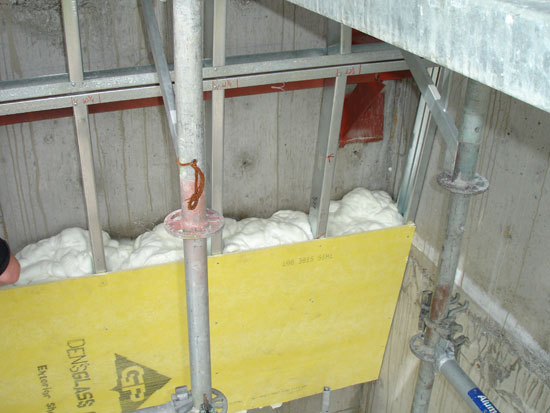Continuous Insulation Systems for Exterior Walls
Controlling Thermal Bridging
We've already discussed the dramatic impact of thermal bridging in stud walls where the studs, particularly metal studs, conduct heat directly and short circuit the effect of the insulation. But the same phenomenon can happen in other common building locations as well.
 |
Medium-density closed cell spray foam insulation has been applied outside of the sheathing on this building to form a continuous insulation layer that covers over all potential thermal bridging locations before being covered over appropriately with a brick veneer. Photo courtesy of ICYNENE, Inc. |
Consider the condition where a stud wall assembly is used on multiple floors of a commercial building. The studs will rest on and be anchored to a floor structure that is most commonly concrete in a metal deck with a total thickness on the order of 4 to 6 inches or more or a wood framed structure that is much thicker. In this type of construction, the insulation in the wall studs stops above and below the floor structure meaning the floor edge is exposed along the full length and width of the building. It is therefore a very significant thermal bridge since there is nothing to prevent heat from being transferred between the inside and the outside of the building along the entire perimeter of the floor construction. The obvious means to overcome this deficiency is to insulate this edge as part of the overall insulation scheme of the building envelope. Hence, the continuous insulation approach that we employ on the walls can and should be extended over the floor edges as well. Using medium-density closed cell spray foam insulation to significantly boost the performance of stud walls, now also dramatically increases the performance of the overall building by covering the floor edges and combatting this otherwise energy draining thermal bridge. In short, the effectiveness of the continuous spray foam insulation is not limited to just the stud wall areas, but to the entire height of the building across multiple floors on all sides.
Another common wall condition that creates unwanted thermal bridges is the area around structural steel or concrete. In many commercial buildings the studs are not the primary structure, rather a steel frame or concrete system is used with studs or masonry infill between. The structural elements act as direct thermal short circuits just as the floor slabs do if they are not protected. This is true for structural elements that are in line with wall framing but it is also especially true for corner conditions which sometimes protrude and get overlooked. Once again, the most effective solution is to provide continuous insulation over the outer faces of these structural elements to stop the unwanted heat transfers. Medium-density closed cell spray foam insulation will effectively cover all of these areas as well and will be particularly well suited to filling any irregular surfaces caused by fasteners, plates, etc. to create a truly continuous thermal enclosure around the entire exterior wall surface of the building.
 |
Spray foam insulation can fill and seal in and around areas that are difficult or complicated for other insulation systems. Photo courtesy of ICYNENE, Inc. |
One final area to address in regards to thermal bridging is not related to the horizontal transfer of heat through the wall system, but rather the vertical transfer of heat that can occur up through a roof parapet. Commonly a parapet extends above the roof line meaning that it extends above the roof insulation level. Often, the thought has been to simply stop the wall insulation at the height where the roof insulation begins. But that leaves the parapet exposed to the exterior without anything to impede heat transfer. In effect, it is doing in the vertical condition what the floor edge was doing in the horizontal condition. By now the solution here should seem obvious—extend continuous wall insulation all the way up the face of the parapet to the top. Then, to complete the envelope enclosure, extend the roof insulation up along the other side of the parapet so the two insulation systems meet at the top of the parapet and close off the thermal bridge. There are a number of ways to detail this, but the intent is the same – stop the unwanted transfer of heat into or out of the building along the entire perimeter of the building. Of course, if there is no parapet at all then the detailing may be a bit simpler, but the important point will be to extend the continuous insulation up the full height of the wall assembly and the roof insulation over it so a truly continuous thermal envelope is created. The same medium-density spray foam insulation used elsewhere on the wall for continuous insulation will work very well here to fill in and close that juncture.
The significance of addressing thermal bridging cannot be overstated. As the above discussion shows the wall area that is compromised in typical building construction without continuous insulation is not limited to the 20 percent or so that we saw in stud wall construction. Rather, by factoring in the effects of floor edges, structural components, and parapets, the total un-insulated area on a building façade could be 30, 40, or even 50 percent depending on the make-up of those systems. Therefore, adding continuous insulation over all of these areas and integrating it across the full wall construction areas will have a significant impact on actual energy performance of the building and the comfort of its occupants.
Conclusion
Spray foam insulation offers a complete energy performance solution for wall construction in commercial design. Low-density open cell spray foam insulation provides an ideal means to completely insulate stud cavities while eliminating the potential for internal convection currents that could otherwise reduce performance. It also provides an effective air barrier to seal all areas and openings in a framed wall cavity. Medium-density closed cell spray foam insulation provides a high-performance solution for adding continuous insulation and an air barrier all in one product on the outer surface of sheathing on a framed wall. It will also cover smoothly and completely over all of the areas that could otherwise provide energy draining thermal bridges. The end result is a total high performance wall assembly solution that can enhance and work with virtually any architectural design approach. And, by virtue of that higher performance, the building owner will reap the benefits of energy cost savings and longevity of building for years to come.
 |
The evolution of insulation starts here. Icynene’s spray foam insulation products are specially formulated to meet the needs of builders, architects, and homeowners. www.icynene.com |








